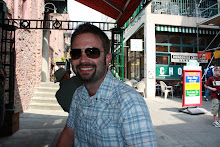
What was Jesus like as a kid? Or as teenager? Of course, we all know the story of how he was born, and many know the stories of him teaching at the temples. But what happened after that? What happened to basis of western theology between the ages of 13 and 30?
Well, these are questions we may never have answers to, but
Christopher Moore has some interesting ideas. "Lamb: The Gospel According To Biff, Christ's Childhood Pal" is a humorous, and of course fictitious account of the life of Christ as told by his best friend Levi who goes by the nickname Biff. The story follows Joshua, (Jesus is Greek for Joshua) and Biff as they search for direction on how Joshua is supposed to be the Messiah. Joshua knows, of course, that he is special, that his father is not Joseph but God, and that he is meant to be the savior of all man-kind. It seems to be kind of a tall order for a young Jewish kid.
Biff gives us this account after being resurrected himself and given the gift of tongues in order to tell his story in modern vernacular. He is forced to stay in a hotel room with an unpleasant angel while he writes his account, learning along the way how drastically the world has changed, and how far we have fallen. While he works on writing his story, Biff covertly reads the New Testament of the Bible, constantly questioning why the people who wrote it omitted so much of Christ's life, including omitting him.
Biff's story tells of his and Josh's journey from Nazareth into the east in search of the three wise men who paid him a visit as an infant. The two reasoned that if anyone would have the answers to how Joshua is meant to be the Messiah, it would be these men. These wise men, it turns out, are in turn a mystic, a Buddhist Monk, and a Hindu Yogi, each of whom have their own unique lessons to teach the son of God, and of course his best friend.
These lessons that take Joshua and Biff far into the east and keep them away from home for almost twenty years teach them, and us, one very important idea: That the true ideals of Christianity are not far removed from the philosophies of the Eastern world. From the mystic they learned the three jewels of the Tao: Compassion, Moderation, and Humility. From the Buddhist monk, they learned the value of losing the attachment to ego and the peace of silent meditation. From the Hindu Yogi, they learned spiritual and physical discipline, along with the search for the Divine Spark (later to be renamed the Holy Ghost by Joshua.)
Along the way, the pair find themselves in countless situations crafted by Moore to pepper the stories with humor, and they are all genuinely funny; although a childhood spent attending church and Sunday school each Sunday helps you get the irony of many situations. A couple in particular stand out: While with the Buddhist monks, Joshua and Biff are taught Kung-Fu, which Biff masters quickly and becomes a finely tuned killing machine. Joshua, however, forbids himself from learning how to hurt people, so the monks create a martial art just for him, a system of defense and counter attacks they call Jew-Do, or the "Way of the Jew".
Anyway, you get the picture. For those of you out there that might be gasping in horror and thinking this is blasphemy and how dare someone write a funny story about the life of Christ, don't start sharpening your axes just yet. This is fiction, a story, the creation of some one's vivid imagination. To be fair, when it counts, Christopher Moore gets it right. But the author does admit in his afterward, probably as a preventative measure, how much of a work of imaginative fiction this book really is.
Moore writes in his afterward, "The book you just read is a story. I made it up. It is not designed to change any one's beliefs or worldview, unless after reading it you've decided to be kinder to your fellow humans (which is okay)..." and "While I've made some attempt to paint an accurate picture of the world in which Christ lived, I changed things for my own convenience, and sometimes, obviously, there was no way of knowing what conditions really existed in the years 1 through 33."
The book is fun, it is funny, and a worthy read. Especially for someone who grew up learning the stories in the Bible and wondering quietly what happened to the stories of when Jesus was growing up? It paints a full and heartfelt picture of who Jesus was and how he grew up to become Jesus Christ.
By the way, if you can get your hands on it, find yourself the Special Gift Edition of this book. It is bound to look like the Bible, complete with gold leaf in the cover lettering and around the edges of the pages, and even the silk ribbon bookmark attached to the books spine. The only thing missing are the maps of the holy land inside the front and back covers.









